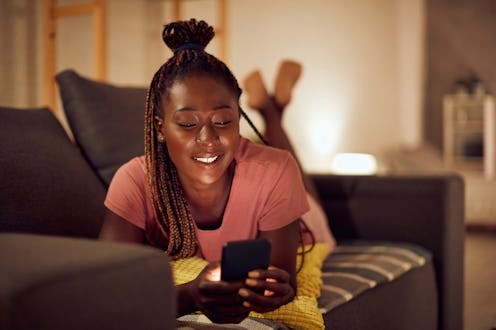Dating
How Does The Hinge Algorithm Work? An Insider Explains
A look behind the dating app.

If your dating app experience includes swiping through all the profiles in your area until you find yourself constantly feeling deja-vu, re-matching with the same users over and over again, or getting stuck in a pattern of potential baes who rarely respond with more than a two-word sentence, rest assured that you’re not alone. In an October 2019 survey conducted by Pew Research, 30% of U.S. adults who participated reported that they’ve used dating apps before, and there’s no doubt that a good majority of those have also run into these issues. So... how on earth do these apps actually decide who you see?
Currently, there are over 3.7 billion views under the search phrase “Hinge algorithm” on TikTok, so it’s clear the people have questions — and Hinge has some answers. While it’s not possible to get full insight into every aspect of the app’s process (understandably so), the Hinge algorithm has some interesting characteristics that match you with your “most compatible” users and decide who you see and see when. Read on for everything that can possibly be shared about how Hinge’s algorithm works.
How Does The Hinge Algorithm Work?
Dating apps typically use an algorithm that takes all your profile data into account to pair you with potential matches, and vice versa. Hinge’s algorithm, specifically, works to “spark deeper conversations between users that, ultimately, lead to great dates,” a spokesperson from the app tells Bustle.
There is a lot of nerd-speak behind this, but for those interested, Hinge uses a system that is partially modeled after the Gale Shapley algorithm — a framework that was created to resolve the “stable marriage problem”, aka a scenario in which an equal number of men and women rank members of the opposite sex based on preference, then all get matched up into pairs in a way where no two partners are paired with someone they didn’t choose. In other words, the idea is that you’re matched with someone who you like and that (in theory) likes you back.
A perfect example of this algorithm at work is Hinge’s “most compatible” feature: “For all daters, Hinge refreshes your ‘most compatible’ every 24 hours based on the latest information we’ve learned about you, such as preferences, previous interactions, and recent activity,” the spokesperson explains. “Through a combination of machine learning and the Nobel-prize-winning Gale Shapley algorithm, [the] ‘most compatible’ [function] pairs members with the person they’re most likely to have a great first date with.”
You can also look at the app’s “standouts” feature to see the algorithm at play. On the “standouts” tab, marked by the star icon at the bottom of your app, Hinge curates an assortment of who it believes to be “most your type.” Once you’ve looked through and picked the person who most piques your interest, you can give them a “rose” (shout out to Bachelor/Bachelorette fans). “All users have a feed known as standouts that refreshes daily to feature outstanding content from people who fit your preferences,” a Hinge spokesperson explains. “To show someone in standouts that you’re interested, you’ll send a ‘rose’ instead of a ‘like,’ which is twice as likely to lead to a date.” As with the “most compatible” feature, Hinge takes into account the preferences you’ve listed on your profile and in your settings (like distance, gender identity, and others like height or political beliefs if you pay for Hinge Preferred), the previous interactions you’ve had with other users, and the recent likes or dislikes that you’ve sent.
How Accurate Is Hinge’s Algorithm?
While the algorithm sounds like it’d work swimmingly in theory, there isn’t really a way to quantify how successful Hinge’s system is at creating perfect pairings. That said, the platform does have some data on how often dates are successful and whether those dates led to a second. “Once two people match, we follow up a few days later via our in-app survey — called ‘we met’ — and ask each person privately if they went on a date and if they’re the type of person they’d like to see again,” the brand’s spokesperson shares. “Hinge is the only dating app that does this, and 80% of our users report going on dates and wanting to see the person again.”
So, if you’re itching to test out Hinge and its various new features (like the fun Hinge video prompts) to find your new boo, try giving it a go. Who knows — you just might end up joining that 80%.